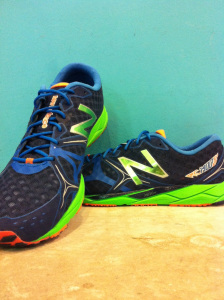The Columbia Montrail Caldorado II trail running shoe is said to be “a responsive varied trail running shoe” that offers “a responsive versatile blend of cushioning and traction to take on any surface” (Running Warehouse). Does it deliver on these advertised promises? See the verdict below.

When I reviewed the Columbia Montrail Fluidflex F.K.T. trail running shoe, I stated: “I would love to see a model from Columbia Montrail that offers additional firmness through the forefoot… twenty to thirty percent more than is present in the Fluidflex.” Well, it appears that the company has produced such a shoe and it’s the Columbia Montrail Caldorado II. This model offers plenty of firmness for those who worried that some of the FluidFoam cushioned shoes might be getting a bit too soft.
The Caldorado II is an attractive trail running shoe with an 8mm drop. It weighs 10.2 ounces, slightly heavier than the 9.5 ounces of the Fluidflex F.K.T., but that’s not a difference you’ll feel on your feet. One retailer has noted that the Caldorado II fits large. I’m not in total agreement with this statement. I think this shoe offers a comfortable fit with plenty of room up front for one’s toes – all 10 of them. The fit is basically retro in nature – reminiscent of how running shoes fit from the late 70s to the early 90s. (A few will recall the very generous fit of the original Adidas Supernova.) However, the Caldorado II does fit snugly around the mid-foot.
Let me state early on that this is a hybrid running shoe. Anyone who runs on city streets or sidewalks to get to a natural trail will appreciate the versatility of the Caldorado II. The shoe is stable on asphalt and concrete, if not quite as stable as earlier Montrail Fluidflex and Fluidfeel models. No worries, it does just fine in accommodating mild to moderate pronators.
On a dirt and gravel covered trail, the Caldorado II provides a secure feel. The shoe gets a B+ grade on a hard-packed dirt trail. It offers nimbleness and the FluidGlide technology – intended to provide “a smooth ride on uneven trail surfaces”, delivers exemplary side-to-side control. (If this were an automobile, one would praise its drifting capacity.)
On a hard rock trail the Caldorado II’s studs produce great grip and the Forefoot Trail Shield rock plate means that one’s feet never undergo punishment.

As good as the Caldorado II is on trails, is it also suitable as a trainer on hard city surfaces? The short answer is “yes.” On tough urban surfaces, the Caldorado II earns a solid B grade in terms of responsiveness. It may not be as springy as some other running shoes but it comes through in terms of bounce back.
One can do some fast training runs in the shoe as it facilitates quick feet turnover and some high-stepping. Unlike some other trail runners, the Caldorado II does not keep one’s feet glued to the ground. This brings to mind something that can be said of all of Columbia Montrail’s models: They may be labeled as trail running shoes, but each model possesses the soul of a racing flat.
The level of cushioning on the Caldorado II is excellent. One’s feet are not going to feel beaten up after a short to mid-distance training or long slow distance run. The key feature of the shoe is its supportive firmness. Runners concerned about the growing reliance on compliant foam midsoles will experience peace of mind with the Caldorado II.

Verdict
During my initial experiences in the Caldorado II, supplied by Columbia Montrail, I feared that the shoe would be too firm to provide relaxed training runs. But that unique firmness though the mid-foot and forefoot – something I had wished for that was delivered – is the shoe’s best feature. This is a model that can be used every day as a secure, supportive trainer and also as an endurance event shoe.
The Caldorado II, which retails for $120.00, will deliver the goods for runners seeking a reliable, durable daily trainer that can also be worn for a 10K or 10 miler, a half or full marathon, or an ultra. I firmly believe this is the best shoe yet from Columbia Montrail.
Highly recommended.
Joseph Arellano
This review was first posted on the Blogcritics site:
http://blogcritics.org/running-shoe-review-columbia-montrail-caldorado-ii/

















